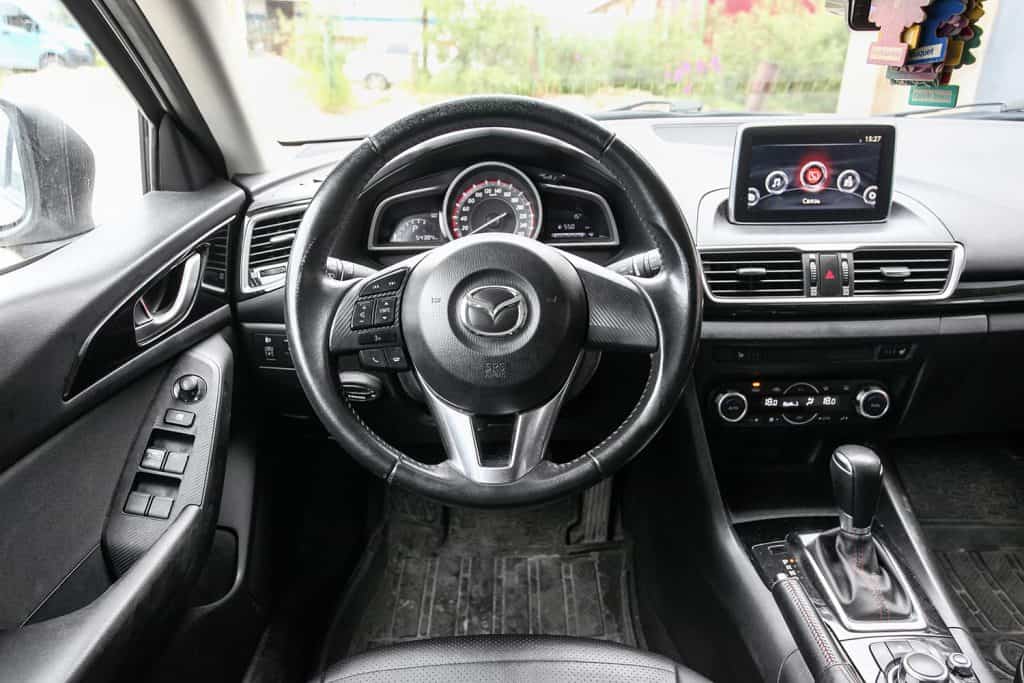Mazda 3 prides itself on class, tenacity, and refinement. Both its engine and interior design speak of excellent qualities. However, you may be wondering whether this vehicle needs synthetic oil. Don't get in a flap as we gladly researched all the answers you need to know!
Synthetic oil is typically needed in Mazda engines because it gives protection to the vehicle in unforeseeable weather conditions. What's more, it reduces contamination and expands the interval between oil changes.
There are so many features that the Mazda 4 guarantees luxury, versatility, and functionality. You can read further and know more about the vehicle and have a thorough discussion on its synthetic oil requirement.

What Is Synthetic Oil?
Synthetic oil is a lubricant that's made of artificially chemical compounds consisting of petroleum components, quality-based oil, and distilled crude oil and is utilized primarily to operate and remain in smooth working order in extreme temperatures.

It was developed in 1929 and was used for almost everything to fuel running vehicles, including high-geared engines such as jets and military machines. In fact, during World War II, Allied Forces (Great Britain, United States, and the Soviet Union) limited oil access to Germany, which made them make use of synthetic oil to maintain their equipment.
Because of that, the American Energy Crisis put out its best work to create better and improved artificial oil to amplify fuel economy, most especially during the 1970s.
Now, a lot of powerful engines such as aircraft, jets, and airplanes require synthetic oil for their high performance. Even car manufacturers recommend using this both on luxury and mainstream engines to obtain fuel efficiency.
Advantages Of Using Synthetic Oil In Mazda 3

An oil change is vitally important for your Mazda 3 as it reduces friction and the possibility of a worn-out engine. It protects your car's engine components and helps the vehicle run smoothly and last longer.
Although there are types of oil you can choose from you will soon understand from the discussion below the great benefits of using synthetic oil for the Mazda 3, such as:
- Synthetic oil flows easily.
- Provides a cleaner engine.
- Eminently resistant to viscosity breakdown. Therefore, it is resilient to extreme heat and friction. Plus, it minimizes other chemical contaminants.
- Extends drain and change intervals.
- Synthetic oil flows easily.
- Synthetic oil is less likely to acidify and oxidize.
- Guarantees more shear stability than other types of oil.
- It has a great chemical quality that is hard to break down and lose.
- Synthetic has a better viscosity index. (VI)
- Guarantees prominent protection from deposit formations in engine hotspots.
- Reduces oil burn-off and oil passageway clogs.
- Decreases the possibility of evaporative loss.
- Optimizes environmental benefits as less used oil waste can be generated.
- Increases horsepower and torque.
- Improves fuel economy, most especially in certain engine configurations.
For the best, you can watch this YouTube video by Wheelsca Official demonstrating the benefits of using synthetic oil.
Or you can check out "Does My Car Need Synthetic Oil?" for additional insights on synthetic oil.
Mazda 3 Engine And Performance

The Mazda 3 sustains a 2.0-liter four-cylinder engine with 150 pound-feet of torque available in the Sedan.
Other engine options are the following:
- 2.5-liter four-cylinder with 186 horsepower and 186 pound-feet of torque
- Turbocharged 2.0-liter four-cylinder with 227 horsepower and 310 pound-feet of torque
- 250 horsepower 320 pound-feet of torque available on 2.5 Turbo and 2.5 Turbo Premium Plus.
It has a standard front-wheel drive and is also available in an all-wheel-drive with a standard six-speed automatic transmission but also has an available six-speed manual transmission for the front-wheel-drive Premium.
According to Forbes, the Mazda has a top speed of 134 mph and can go from 0 to 60 in just 5.6 seconds. What's more, Mazda users have agreed that it has supple handling and braking. Plus, it complies with accurate steering, so it's not only cool for the city but sporty for off-road driving as well.
Check out this awesome video on YouTube by Cars.com doing a test drive on Mazda 3.
Mazda SKY ACTIV Engine
Mazda manufacturers pride the Mazda 3 with a SKYACTVIV engine that has promising next-generation technology by featuring a Spark-Controlled Compression Ignition engineered to develop an engine with an ideal internal combustion mechanism.
It has a spark plug ignition that controls compression ignition resulting in a great performance in the vehicle. In addition to that, it expands the vehicle's rpm and cleans exhaust emissions. Plus, it provides an initial response to fuel economy.
Mazda manufacturers have poured out a lot of creativity and passion for developing this engine. The concept of this was inspired by the Hiroshima Heritage, which they plan to make a significant mark in the history of making cars through inspiring stories of their culture.
This SKY-ACTIVE engine raises the bar high! For your convenience, you can check out Roadshow's YouTube video highlighting this pristine and cultivated vehicle feature.
What's The Difference Between Synthetic Oil And Conventional Oil?
Conventional oil is filtered from crude oil and is widely known to be remarkably cheap compared to synthetic oil, costing 10% less. This type of oil has a lot of disadvantages as it largely affects the maintenance, performance, and lifespan of the vehicles.
However, this type of oil would best suit older models of vehicles that are built to dwell on conventional oil. Additionally, vehicles with seals, gaskets, and plugs may not be too tight. Conventional oil flows slower, and it is best suited to be fueled on aging vehicles because of its thick lubrication.
Now, knowing that the Mazda 3 is equipped with a modern technological engine, it is best to not lubricate it with conventional oil. Doing so may cause great harm to the welfare of the engine.
For the best, here is an informational YouTube video from Engineering Explained scientifically discussing the difference between synthetic and conventional oil.
In case you're wondering other factors to consider on the usage of synthetic oil, you can read "Is Synthetic Oil Bad For Old Engines?"
Can You Switch Between Conventional And Synthetic Oil?

There is some point in our lives that we have to adjust our budget a bit according to what we can afford, and that's okay! Switching between conventional and synthetic oil is definitely fine. Don't get too swamped over traditional oil myths.
Both conventional and synthetic oil are compatible with one another. What's more, it can do no harm to your engine, and it doesn't really affect your travels. But if you have gone all out for a full high-quality synthetic oil, then it may not be ideal when switching back to the conventional one.
Zima Automotive explains just how this oil switch works. Additionally, he provides more ideas on oil changes and clarifies some truth behind oil myths and other automotive concerns.
How Long Does Synthetic Oil Last?

Most of the cars manufactured in the recent generations have demanded to have full or blended synthetic oil requirements. This is for the reason that synthetic oil proves itself to be long-lasting in a lot of factors.
Firstly, synthetic oil can last about six to 12 months before replacement. However, this is not the mere basis for longer oil-change intervals. As a matter of fact, it depends on the vehicle's driving pattern, vehicle care, and riding condition. Mileage and viscosity index may also play a part in this regard.
Second, synthetic oil can run on an average interval of 7,500-10,000 miles before replacement, and yet these numbers still greatly depend on the quality of the synthetic oil purchased.
Castrol's Full Synthetic Motor Oil is proven to perform vigorously and can reach up to 20,000 miles between oil changes. At the same time, it maintains the viscosity and extreme force of the engine.
Click here to see Castrol's full synthetic oil on Amazon.
For a thorough understanding of the longevity that synthetic oil guarantees, you can read "Will Synthetic Oil Make Your Engine Last Longer?"
Can You Use Semi-Synthetic Oil For Mazda 3?

In case you're considering opting for semi-synthetic oil as an alternative or another choice for you to consider for your vehicle maintenance, then you can totally go for this oil type.
The Mazda manual recommends using 0-W 20 oil for the SKYACTIV-G engine. Consequently, oil in 0-W 20 grade is available for both semi-synthetic and full synthetic formulations, so it's definitely safe.
As for the other engine types and models, it is best to consult the owner's manual for a complete preference.
Castrol's synthetic blend motor oil can guarantee the same functionality provided by full-synthetic oil. It helps prevent deposit build-up and has a superior oil burn-off that assures engine stability and minimizes the chances of wearing it out.
See Castrol's semi-synthetic oil on Amazon.
Final Words

Over and above all of that, it is worth to noting that the SKYACTIV engine that Mazda 3 has is preferable to use full synthetic oil for a lot of reasons that include proper maintenance and care for the vehicle. You may also use semi-synthetic oil or switch between synthetic and full-synthetic.
But the last call is all up to you. Choose wisely and drive safely!



MAZDA DEALER INSISTED MY 2021 MAZDA 3 TURBO TAKES NON SYNTHETIC OIL. THE SERVICE MGR EVEN SHOWED THIS TO ME IN HIS BOOK THAT THIS USES CONVENTIONAL OIL. I LOOKED IN MY MANUAL AND SURE ENOUGH IT SAYS CONVENTIONAL. I NEVER HEARD OF A TURBO CAR BEING SPECD FOR CONVENTIONAL OIL. IS THIS A TYPO IN MAZDA LITERATURE?? SOMEONE KINDLY REPLY ON THIS PLEASE.